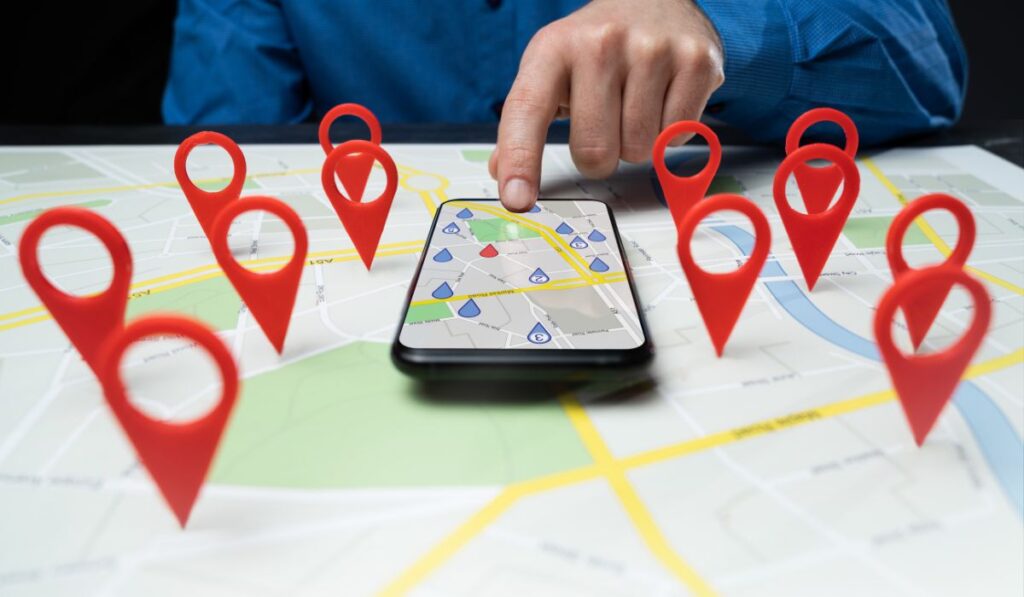Did you know 46% of Google searches are local? This shows how key local SEO is for businesses. In today’s world, where to include city names in blogs aimed at local SEO is a big question.
At Zen 9 Marketing, our experts are here to help you navigate local SEO. We’ll show you how to place city names in your blog. Our aim is to increase your local search visibility and reach customers nearby.
Local SEO best practices have changed. Knowing where to put geographic keywords is vital. We’ll cover how to optimize your blog titles and create location-specific content. These tips can improve your local search rankings and attract more customers.
Ready to boost your local SEO? We’ll share strategies to make your blog a local search leader. By the end of this guide, you’ll have the tools to make your business stand out in local search results.
Key Takeaways
- Local searches make up 46% of all Google queries
- Strategic placement of city names can boost local SEO
- Optimizing blog titles with location keywords improves visibility
- Location-specific content drives engagement and conversions
- Proper use of city names can increase click-through rates by 30%
Understanding the Fundamentals of Local SEO City Targeting
Local SEO city targeting is key for businesses wanting to reach nearby customers. By optimizing content for local search, companies can greatly increase their visibility in local results. Let’s explore why this is important and how it affects your online presence.
Why Geographic Keywords Matter
Using location keywords is vital for connecting with local people. These terms help search engines know where your business is, making it easier to show up in local searches. With 46% of Google searches being for local businesses, geo-targeting is very important.
Impact on Search Engine Rankings
Search engines look at three main things for local rankings: distance, relevancy, and credibility. Claiming your Google My Business profile and keeping your NAP (Name, Address, Phone) info the same everywhere helps you show up in local search results and map packs.
Local Search Behavior Patterns
Knowing how people search locally is key for good SEO. Using location keywords in a smart way can catch this intent. Here are some stats:
- 78% of local searches lead to offline purchases
- 89% of people search for something local on their phone at least once a week
- 18% of all mobile local searches lead to sales within 1 day
By matching your SEO strategy with these patterns, you can effectively target and convert local customers.
Strategic Placement of City Names in Blog URLs
URLs are key in city-specific SEO tactics. We’ll look at how to use location info in URLs to boost local search rankings.
Best Practices for URL Structure
Make your local content URLs short and clear. Put the city name early in the URL. This helps search engines see your content’s location quickly.
City Name Position in URLs
Putting the city name first in your URL helps a lot. For instance, “example.com/chicago-best-pizza” works better than “example.com/best-pizza-in-chicago”.
Multiple Location URL Strategies
If you serve many cities, make separate URLs for each. This focused approach can improve your local SEO. Using this method can increase your local visibility. It makes it easier for people nearby to find you.
| URL Structure | Effectiveness | Example |
|---|---|---|
| City Name First | High | example.com/chicago-seo-services |
| City Name Last | Moderate | example.com/seo-services-chicago |
| No City Name | Low | example.com/seo-services |
Optimizing your URL structure with these tactics sends clear signals to search engines. It can help you rank better in location-specific searches. This attracts more local customers to your business.
Where to Include City Names for Local SEO in Blogs
Geo-targeted content is vital for better local search visibility. Placing city names in blogs can greatly help your local SEO. Let’s look at the best places to put these location markers for the best results.
Begin with your blog’s title tag. Adding the city name here helps search engines and readers. Then, include the location in your first paragraph. This tells Google your content is for locals.

Use H2 tags for city names in your blog’s headers. This makes your content more structured and local. Remember to end your blog with location mentions. This makes your content more specific to the area.
Creating a maps section with your city name in the title is smart. It makes your blog easier to use and provides useful info. Local SEO services say this is key.
| Local SEO Element | Impact on Visibility |
|---|---|
| City Name in H1 | High |
| City in First 150 Words | Significant |
| Maps Section with City | Moderate to High |
| City in Last 150 Words | Moderate |
By using these tips, you’re not just boosting local SEO. You’re making content that speaks to your local audience. This drives engagement and sales.
Optimizing Meta Elements with Location Keywords
Mastering localized SEO techniques is key for businesses wanting to top local search results. We’ll look at how to use location keywords in meta elements to increase visibility and draw in local customers.
Title Tag Optimization
Title tags are your first chance to catch someone’s eye in search results. Keep them under 60 characters and include your main location keyword. For example, “Best Pizza in Chicago | Joe’s Pizzeria” combines location and service well.
Meta Description Best Practices
Write compelling meta descriptions that use location keywords. Use location keywords naturally to boost click-through rates. A good meta description might be: “Craving authentic Chicago-style pizza? Visit Joe’s Pizzeria for the best slice in town. Order now for pickup or delivery!”
Header Tag Implementation
Use header tags (H1, H2, H3) to organize your content and include location keywords. This helps search engines see your page’s local relevance. For example, an H1 tag could be “Chicago’s Favorite Pizzeria – Joe’s”.
By using these strategies, you’ll have a better chance of showing up in local search results. Remember, 77% of consumers use Google for local business searches. So, optimizing your meta elements is vital for reaching this audience.
| Meta Element | Best Practice | Example |
|---|---|---|
| Title Tag | Include location + service | Best Pizza in Chicago | Joe’s Pizzeria |
| Meta Description | Use location naturally | Craving authentic Chicago-style pizza? Visit Joe’s Pizzeria… |
| Header Tags | Incorporate location keywords | H1: Chicago’s Favorite Pizzeria – Joe’s |
Using these SEO techniques can greatly improve your local search visibility. Integrating SEO into your content strategy is essential for reaching and engaging your target audience effectively.
Creating Location-Specific Content that Converts
Local SEO is key in today’s digital world. Creating content specific to your area is a top strategy for businesses to improve their online. This helps turn local searchers into customers. Let’s dive into making content that speaks to your local audience and boosts conversions.

When adding city names to your blog for local SEO, focus on relevance. Make your content meet local needs and interests. For instance, a plant nursery could write about the best plants for their local climate.
To enhance your local SEO:
- Include local landmarks and events in your content
- Use local customer testimonials
- Showcase local projects to build trust
- Create content that reflects local values and culture
Searchers using specific city names are likely to buy. Create detailed landing pages of 2500-3000 words. This gives valuable info while pleasing search engines. Mix local keywords with useful content to avoid penalties.
Lastly, add a strong call-to-action. Use 3-5 words that mix action verbs with your business offer. By doing this, you’ll make content that ranks well and converts visitors into loyal customers.
Leveraging Local Business Schema Markup
Local business schema markup is a key tool for better local search results. It helps us show up more in search results and draw in local customers. Let’s dive into how to use schema markup for local SEO success.
Schema Types for Local Businesses
When adding location keywords to schema markup, picking the right type is important. LocalBusiness is the base, but we can get more detailed with subtypes like Restaurant or Store. This helps search engines get a clearer picture of our business.
Implementation Guidelines
To use local business schema well, focus on these key points:
- Business name, address, and phone number (NAP)
- Operating hours
- Accepted payment methods
- Products or services offered
- Customer reviews and ratings
Using JSON-LD format is best for adding schema markup to your site. It’s favored by search engines and simpler to use.
Testing and Validation Methods
After setting up schema markup, testing it is key. Google’s Structured Data Testing Tool can spot errors and confirm if it’s right. Regular checks keep our local business info accurate, boosting our chances in search results.
By using local business schema markup smartly, we can greatly improve our local SEO. This makes us more visible in search results, drawing in more local customers.
Building Local Authority Through Content Strategy
Building local authority is key to dominating city-specific SEO tactics. Creating a robust content strategy focused on local themes can significantly boost your visibility in local search results. By consistently incorporating location-specific information, you’re not just improving your SEO – you’re positioning yourself as a local expert.
Let’s look at some eye-opening stats that highlight the importance of local SEO:
| Statistic | Impact |
|---|---|
| 93% of local searches involve Google My Business listings | High visibility for optimized listings |
| 68% of customers avoid businesses with incorrect online info | Accuracy is key for customer trust |
| 53% of websites miss traffic due to lack of backlinks | Local link building is vital for SEO success |
To build local authority, we recommend focusing on creating valuable, location-specific content that resonates with your local audience. This could include covering local events, addressing regional issues, or showing local success stories. Remember, effective local keyword placement strategies are key – naturally integrate city names and local terms into your content.
Engaging with other local businesses and organizations can also enhance your local authority. Consider collaborating on content, cross-promoting services, or participating in community events. This not only improves your local visibility but also creates opportunities for valuable backlinks, which are essential for boosting your site’s organic traffic.
By implementing these strategies, you’ll be well on your way to establishing strong local authority and improving your rankings in local search results.
Learn Where to Include City Names for Local SEO in Blogs and More from Zen 9 Marketing
We’ve looked at how important geo-targeted content is for local search visibility. Adding city names to your blog posts can really help your local SEO. By using location keywords in your titles, descriptions, and headings, you can get more seen in local searches.
Our guide showed how to naturally add city names to your content. This can lead to more clicks and better engagement with locals. Remember, making your content local-friendly is a continuous task that needs dedication.
Using these strategies can bring great results. Some businesses have seen a 50% rise in foot traffic. Remember, local SEO is about connecting with your community and adding value to local customers. Start using these tips today and see your online presence grow.

